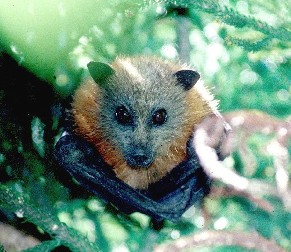Grey-headed flying-fox

Common name: grey-headed flying-fox
Scientific name: Pteropus poliocephalus
Family: Pteropodidae
Conservation status: This species is listed as Least Concern in Queensland (Nature Conservation Act 1992) and is Vulnerable nationally (Environment Protection and Biodiversity Conservation Act 1999).
Description: The grey-headed flying-fox is the largest Australian bat with a wingspan of up to one metre. It has dark-grey body fur, a grey head, and a distinctive reddish-brown collar. It is also the only flying-fox with hairy legs right down to its ankles.
Habitat and distribution
The grey-headed flying-fox occurs along the south-east coast of Australia, from Rockhampton in central Queensland through New South Wales to western Victoria. During the last few years, the grey-headed flying-fox has also been recorded from Adelaide. However, only a small proportion of this range is used at any one time as the species selectively forages for where food is available. They look for food in most habitats that contain flowering and fruiting trees including closed forest, open forest, woodlands, and urban parks and gardens.
Life history and behaviour
Grey-headed flying-foxes are social and nocturnal. During the day they gather in camps, hanging from trees or other structures. One camp can contain tens of thousands of bats. The size and location of camps changes depending on the availability of food, and their social organisation is complex. Camps can also contain black and little-red flying-foxes.
Grey-headed flying-foxes have a range of vocalisations, with more than 20 different calls used for communication.
During the mating season (March-April) large camps are formed. Females give birth to a single young in October-November, which is carried by the mother (even during flight) for four to five weeks. The young are then left at the camp while the mother forages, and are dependent on their mother for up to four months.
During the evening, grey-headed flying-foxes leave their camp to forage. They can fly up to 50 kilometres in search of food, and use their good eyesight, smell, and the sound of other bats feeding, to help them locate flowers and fruit. Although they can feed in orchards, this seems to occur when natural foods are scarce, and the species has a preference for the nectar and pollen from eucalypts, melaleucas and banksias. Grey-headed flying-foxes are an important pollinator and seed-disperser of many trees, and play a key role in the maintenance of forest habitats.
Threatening processes
Grey-headed flying-foxes are threatened by any activity that destroys their foraging and roosting habitats, such as clearing of vegetation and urban development. In some areas they are also threatened by people who illegally kill them to protect their orchards. Killing flying foxes is illegal in Victoria but can occur lawfully under a licence in Queensland and New South Wales.
Recovery actions
- Identify and map important foraging and roosting habitats
- Prevent the destruction and degradation of important forested habitat, through: identifying guidelines to protect habitat; appropriate zoning; identifying development alternatives and incentives to retain habitat and educating communities.
- Encourage community partnerships and initiatives that protect important habitats, and where possible re-vegetate with foraging trees for grey-headed flying-foxes
- Work with orchardists to improve the image of grey-headed flying-foxes, and to identify and implement non-destructive methods to protect fruit crops, such as: appropriate netting (not monofilament netting) that is not hung loose over trees (which can entangle bats and birds)
- Reduce negative public attitudes and conflict with humans
- Develop accurate methods for monitoring population size
Listen
Listen to an audio clip of the grey-headed flying-fox
Related information
Churchill, S. 2009. Australian Bats (second edition). Allen and Unwin, Sydney.
Department of Environment and Science. 2013. Bats.
Duncan A, Baker GB and Montgomery N (Eds.). 1999. The Action Plan for Australian Bats. Environment Australia, Canberra.
Menkhorst, P and Knight, F. 2010. A Field Guide to the Mammals of Australia (third edition). Oxford University Press, Melbourne.
Van Dyck, S and Strahan, R (Eds.). 2008. The Mammals of Australia (third edition). New Holland Publishers, Sydney.


